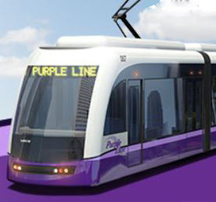Myths and Facts About the Maryland Transportation Budget
Myth: People want Maryland to solve congestion by building more roads.
Fact: In a Washington Post poll about traffic congestion last year, 62% of Washington-area residents wanted government to focus on transit. Only 30% wanted government to focus on roads.
Myth: Drivers subsidize transit riders through the gas tax.
Fact: Everybody, whether they drive or not, subsidizes highways through the exemption of gasoline and vehicle sales from Maryland's 6% sales tax. Marylanders must pay a sales tax of 6% on almost everything we buy. But we do not have to pay this sales tax when we buy gas or cars. Both driving and transit are subsidized by taxpayers.
Myth: User fees pay for highways.
Fact: The tax on gas is only slightly higher than the 6% sales tax paid on most things Marylanders buy. With gas going for $3.60 a gallon at the pump, the gas tax of 23.5¢ per gallon is 7% of the price. Those who choose to buy gasoline and cars rather than something else are taking money out of the general fund, which pays for government services used by everyone, and putting it into the Transportation Trust Fund – they are not paying a “user fee.” The only real user fees drivers pay are car registrations and 1/7 of the gas tax – the 1% difference between the gas tax and sales tax.
Myth: Maryland's Transportation Trust Fund gets most of its money from drivers.
Fact: Most of the money in the TTF is a subsidy from general taxpayers. Total revenues (other than federal aid) are about $2.3 billion, of which only $453 million is user fees from drivers (vehicle registration fees plus 1/7 of the gas tax). Maryland Transit Administration riders pay $125 million per year in fares into the TTF, and it receives $263 million in airport and port user fees.
Myth: Transit riders don't contribute much to the cost of transportation in Maryland.
Fact: In addition to the $125 million paid into the TTF, Maryland residents pay about $302 million in fares and parking fees to the Washington Metro and $11 million directly to MTA commuter bus operators. This makes a total of $438 million in user fees paid by transit riders.
Sources: Maryland Dept. of Transportation, Comprehensive Annual Financial Report 2010, pp. 79, 82; WMATA, Approved Fiscal Year 2012 Annual Budget, p. II-14; WMATA, Transit Ridership Trends and Markets, March 2009, pp. 17, 28; Washington Post transportation poll, March 25-29, 2010; commuter bus fare data from T. Owens, MTA. $302 million is 40% of Metro's FY11 passenger revenues; Maryland residents are 40% of Metrorail riders.

